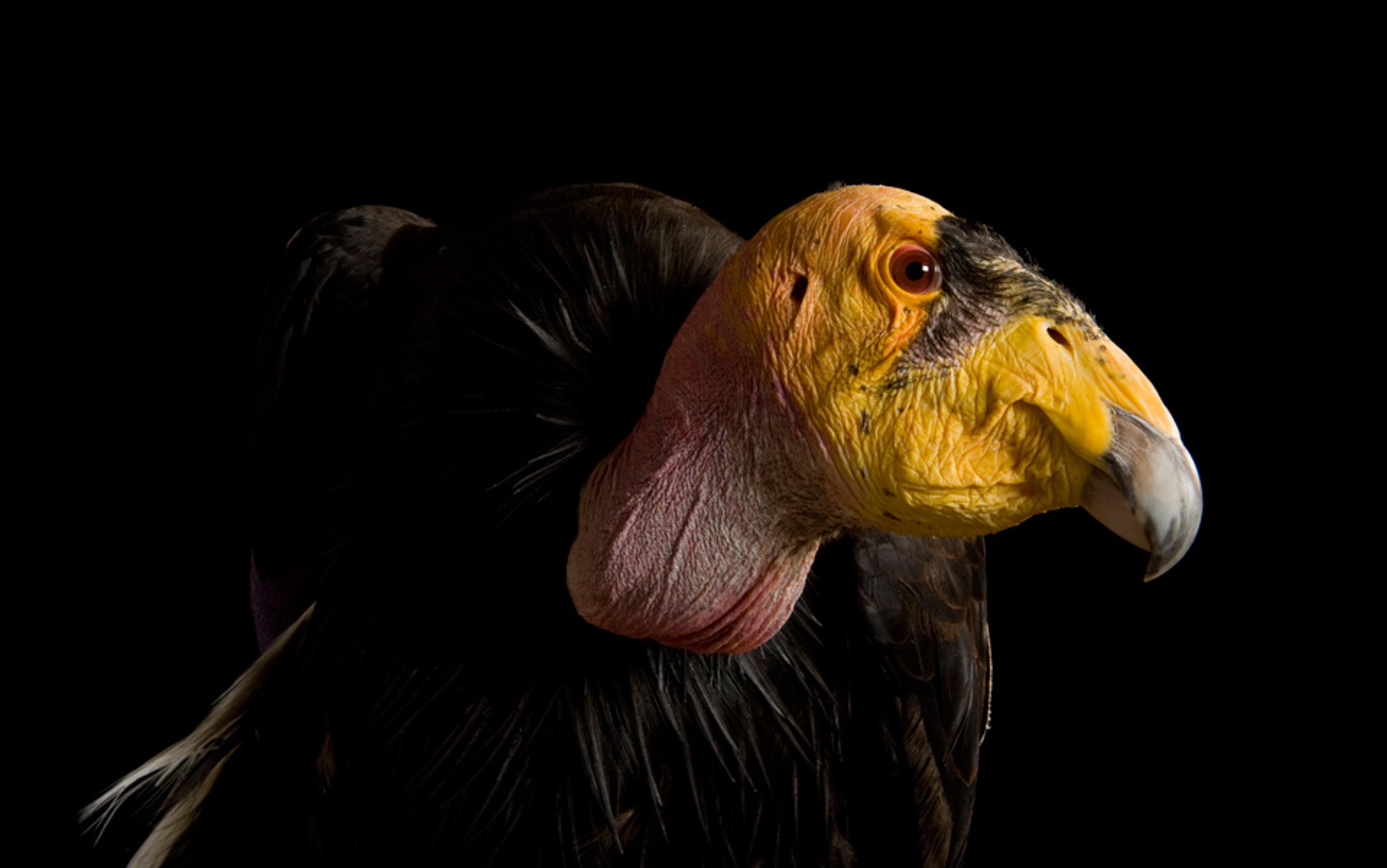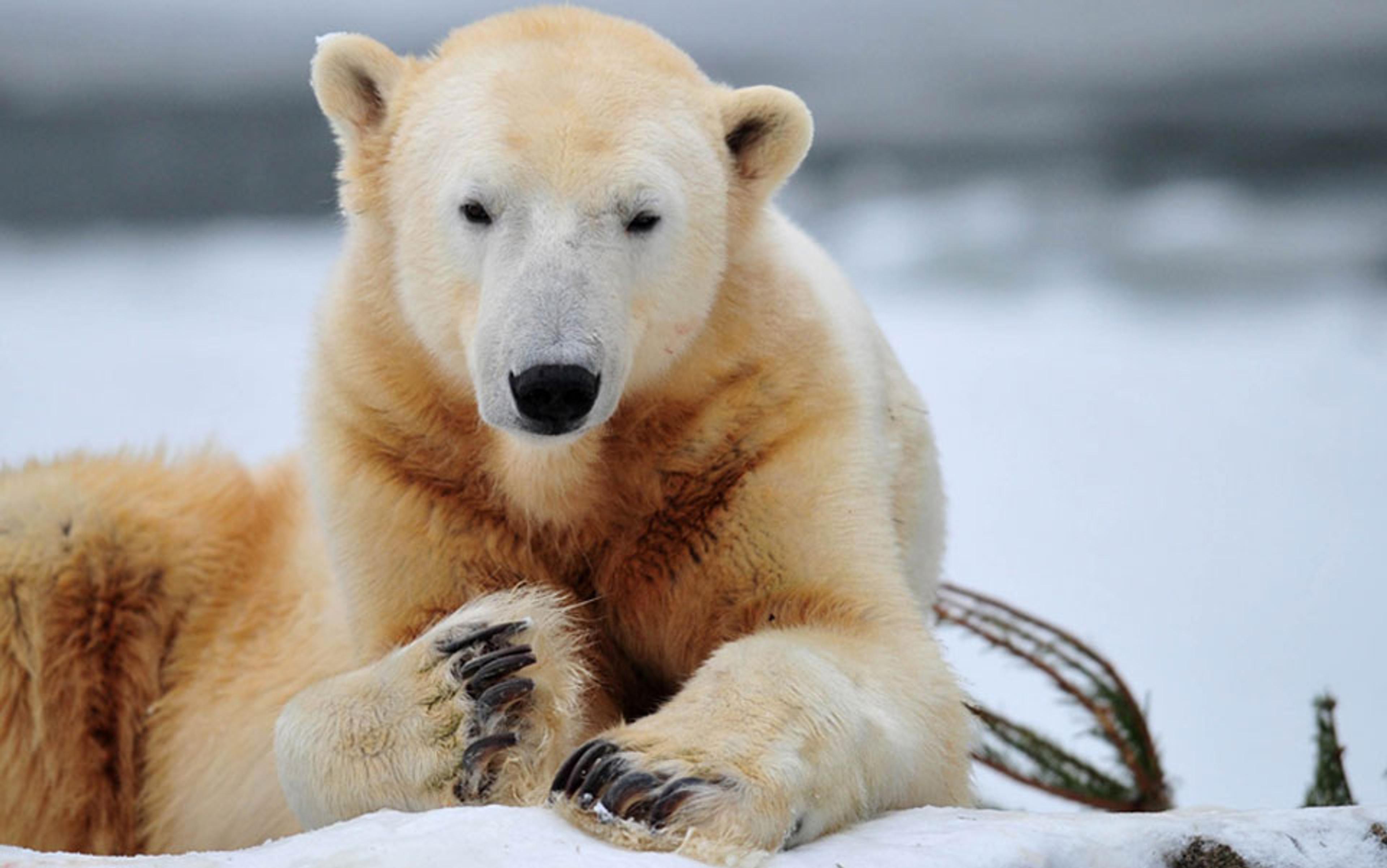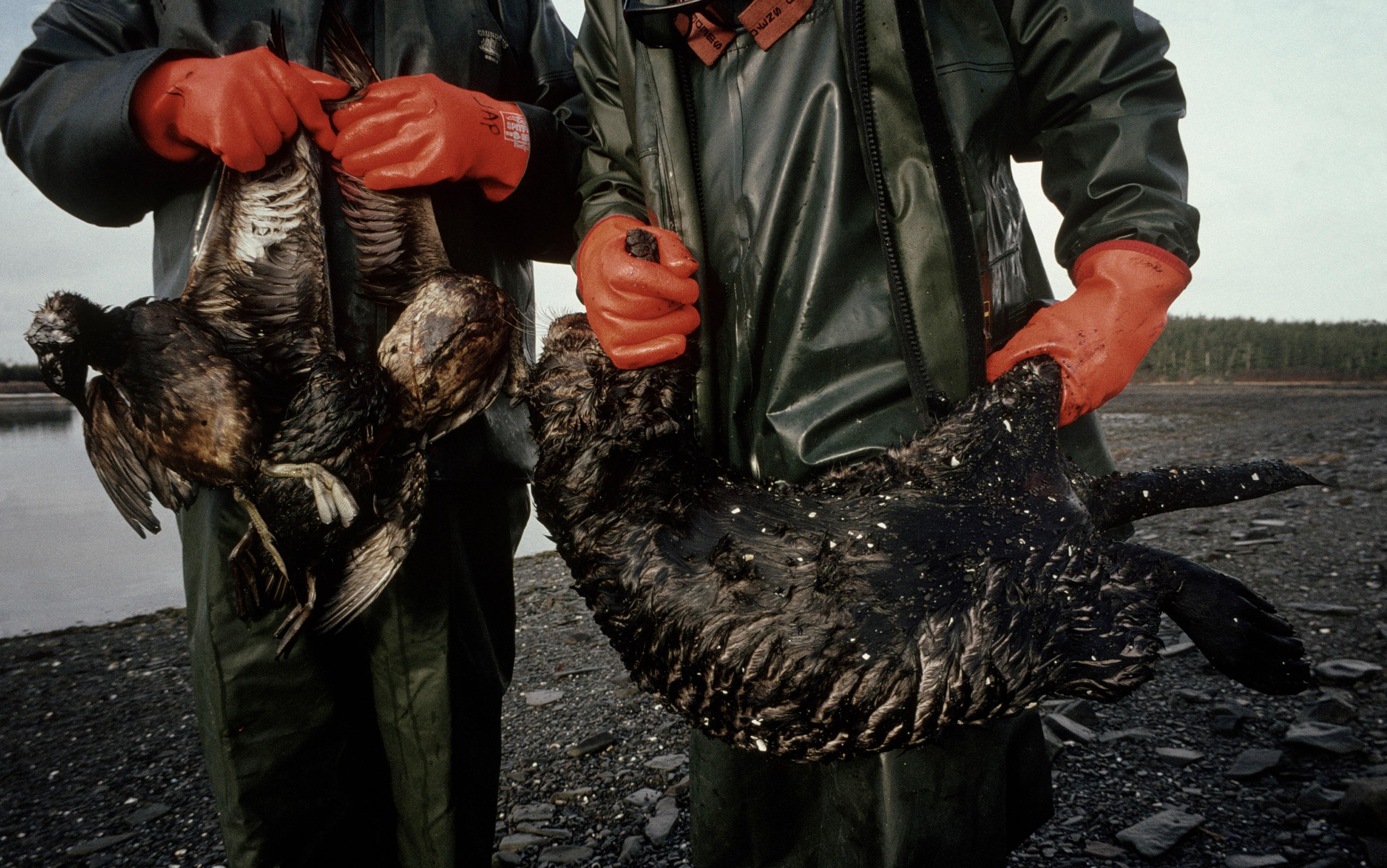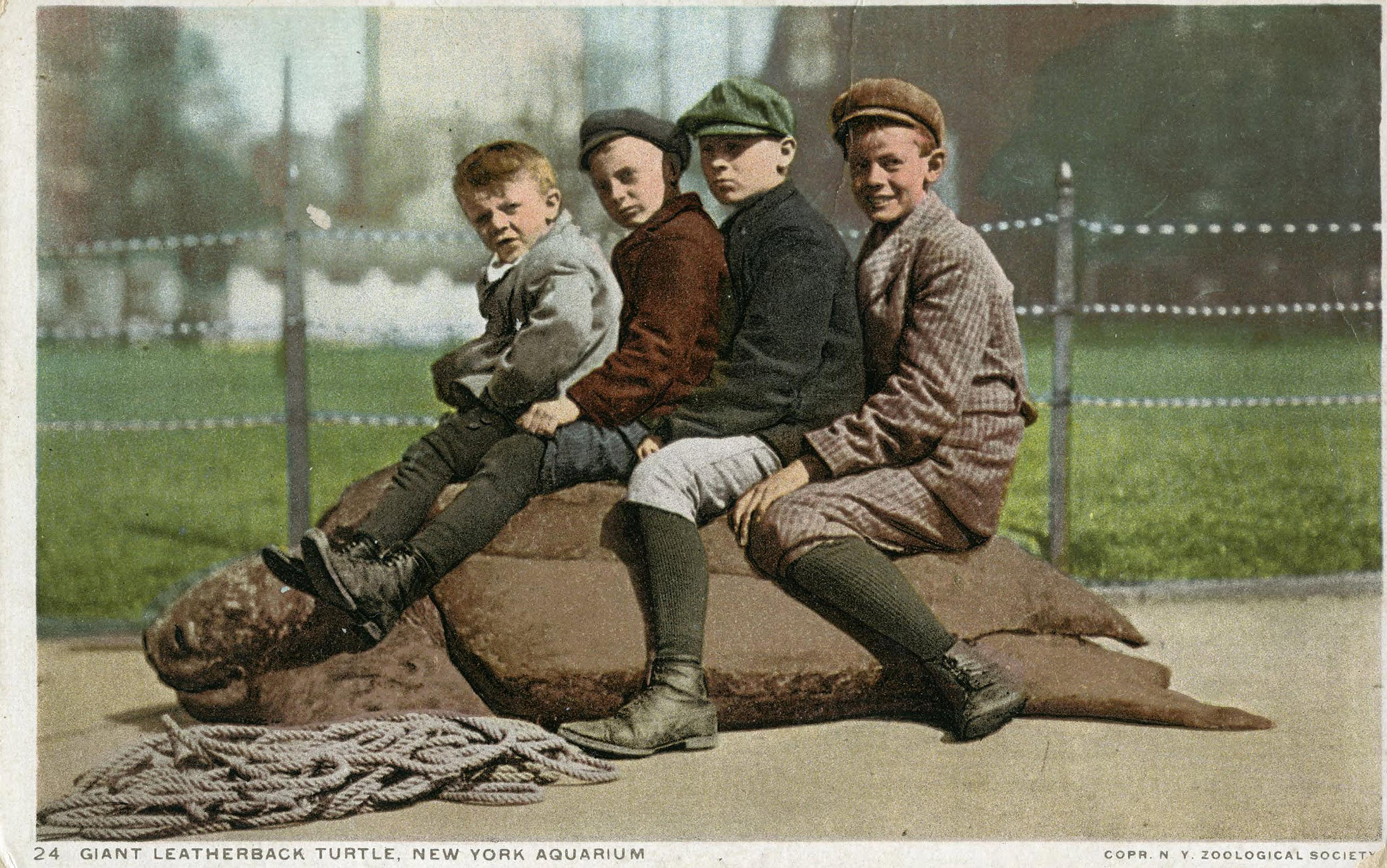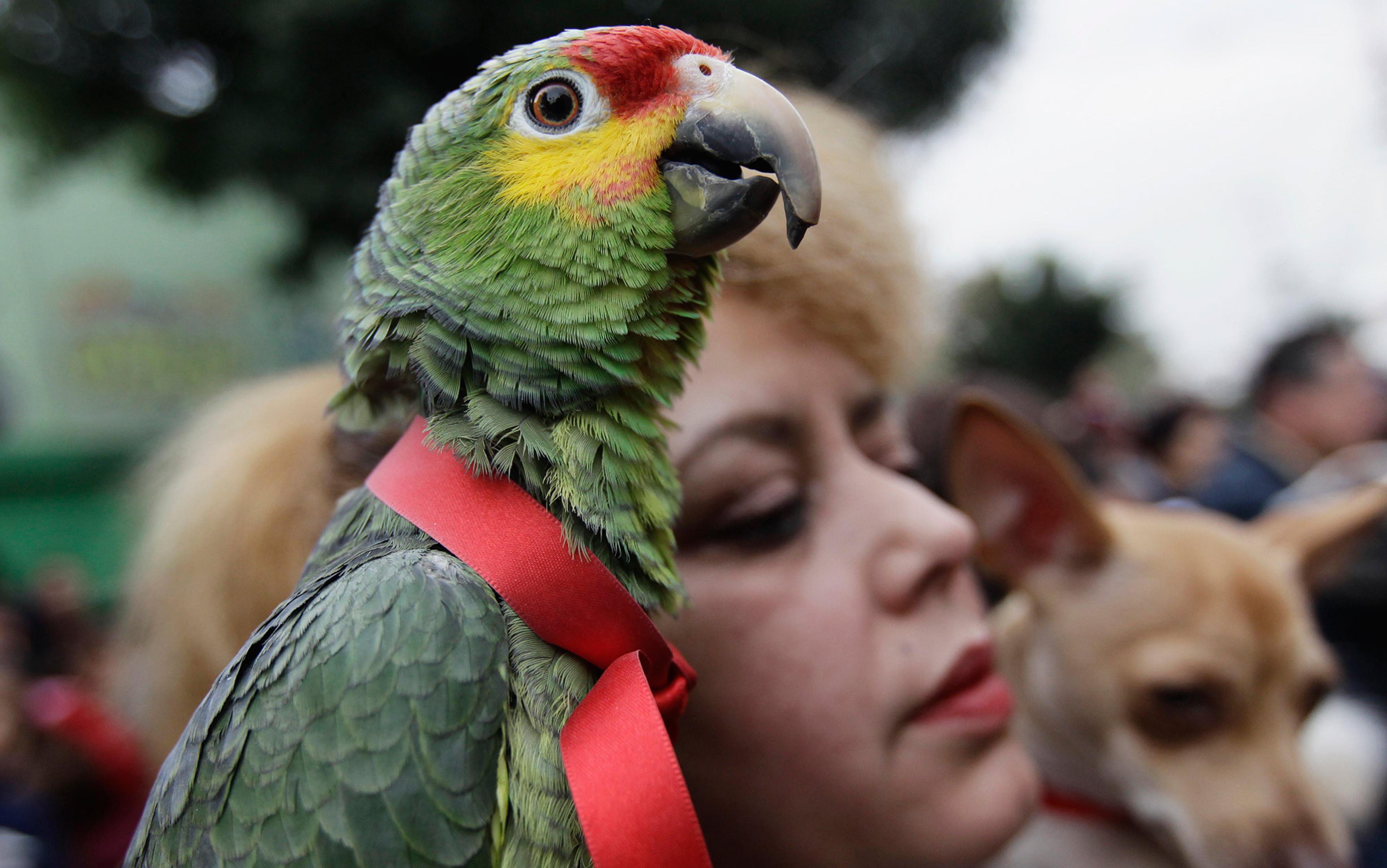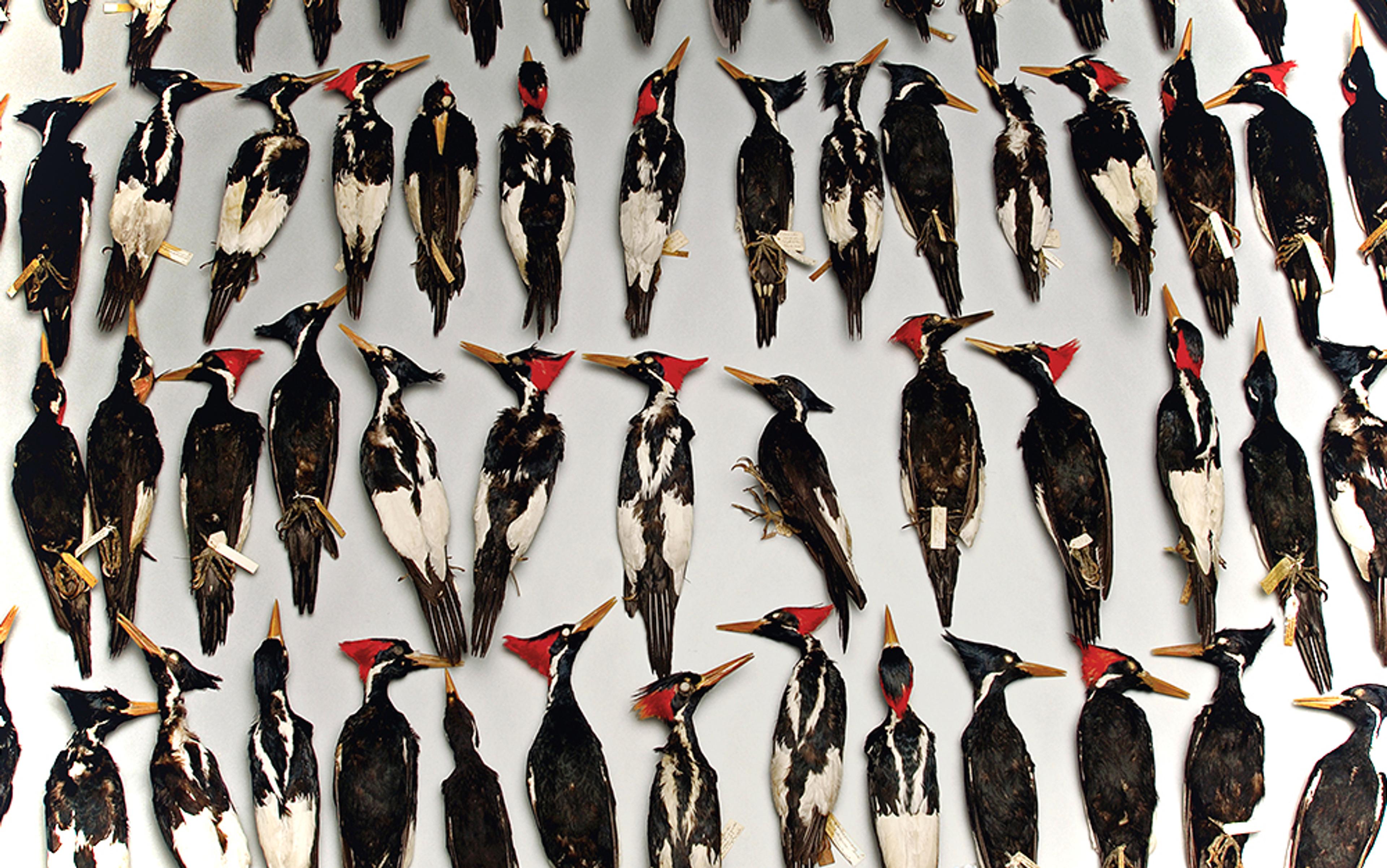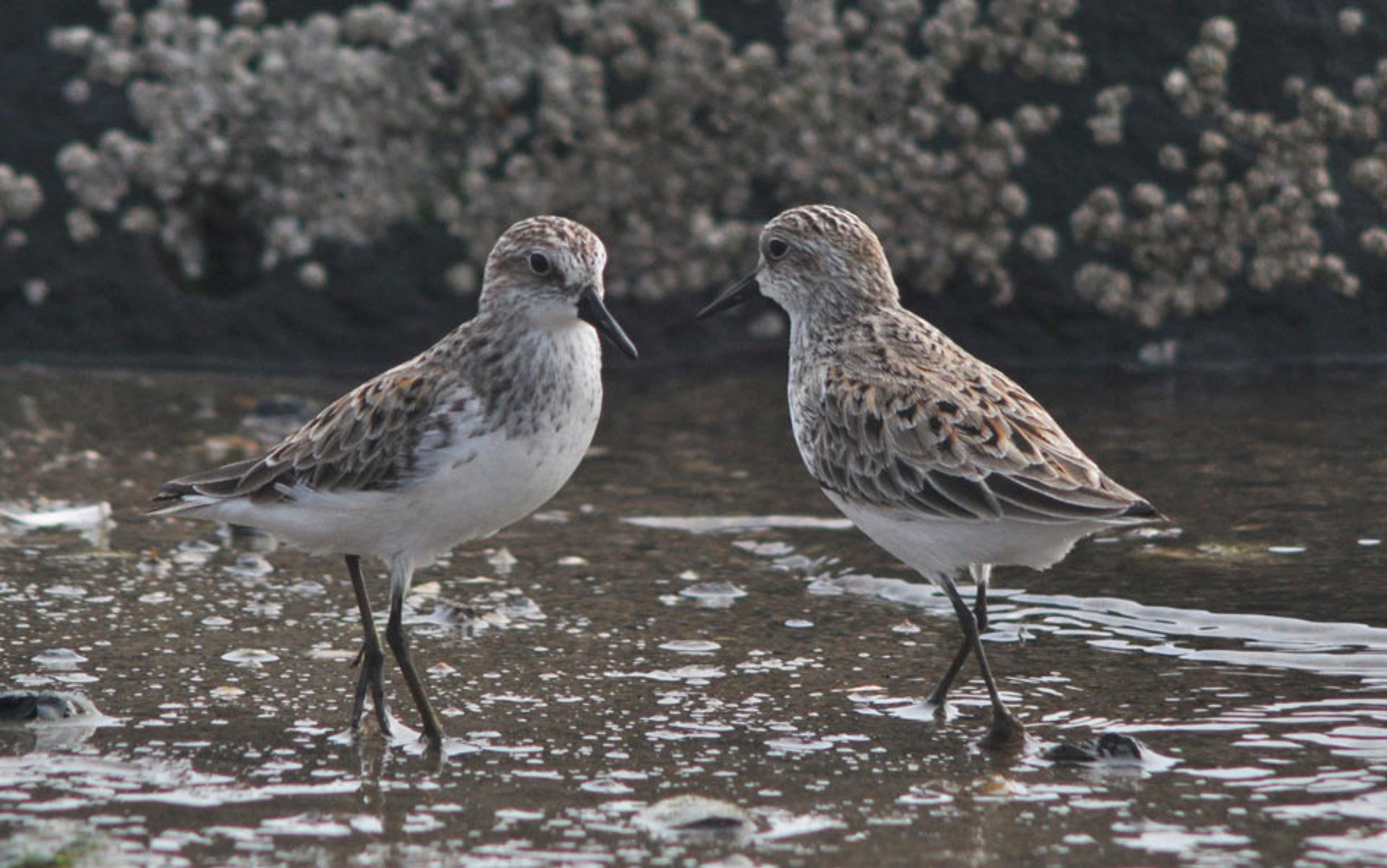The condors wouldn’t leave Les Reid alone. In the late 1990s, a pack of them regularly showed up at his house in Pine Mountain Club, California, a small community northwest of Los Angeles. They clambered around on his roof, making a racket. They perched, one by one, on his large patio umbrella, seeming to enjoy the slow slide down its slippery surface and onto the deck below. Once, Reid, a former member of the Sierra Club’s board of directors, came home to find that eight young condors had ripped a hole in his screen door and were enthusiastically tearing apart his mattress. When he’d walked in on them, one of the birds had a pair of his underwear dangling from its beak.
Meanwhile, in Los Angeles and San Diego, the scientists and zookeepers who had been responsible for these birds since birth were shaking their heads in frustration. This was not the behaviour they’d hoped for when they began releasing their avian charges into the wild in 1992.
California condors are evolutionary relics of the Pleistocene, when they soared over huge swathes of North America and fed on the carcasses of mastodons and sabre-toothed cats. With 10ft wingspans, spiky neck ruffs that resemble Elizabethan collars, and mottled bald heads that range in colour from bright pink to sickly yellow, they are hardly beautiful. Nonetheless, condors have a certain mystique; in his book Condor (2006), John Nielsen describes the archaic birds as ‘the soul of the wilderness’. Although their range has shrunk and their numbers dwindled, condors can still fly up to 100 miles each day in search of food. They read the wind and build their nests in caves carved into cliff faces. They navigate a complex social hierarchy. They do not break into houses and eat underwear.
Angry conservationists accused Reid of corrupting the condors by illegally supplying them with raw meat from the local grocery, a charge he vigorously denied. After all, he’d fought to protect the condor’s range back in the 1960s, when he and his wife would often see the vultures on hikes, soaring miles above them. ‘That’s the way you’re supposed to see a condor,’ he told Nielsen, decades later. He believed that such wild birds deserved to be left alone, and he knew better than to tempt them toward civilisation.
That hands-off approach to protecting the condor was shared by most mid-century conservationists. But when the total condor population dropped to a mere 22 birds in 1987, scientists decided they needed to take aggressive action to save the species. So they rounded up every last wild condor and brought them to live in the Los Angeles Zoo and the San Diego Zoo Safari Park.
These birds proved prodigious breeders and, a decade later, their children were being regularly released in California and Arizona by scientists working with the condor reintroduction programme. The mischievous birds that began showing up at Reid’s house were members of this zoo-bred generation. And it wasn’t just the Pine Mountain Club condors that were acting strangely. Around the same time, condors released near the Grand Canyon posed for photographs and swooped past hotel balconies to wild applause from the guests. They lurked along the edges of trails and lunged at passing hikers, ripping off their shoelaces. A field crew in Arizona told The New York Times in 2003 that they’d seen four condors experimenting with what appeared to be group sex. The scientists tasked with keeping the young birds in line (and away from people) compared the job to running a rowdy middle school.
If the captive-breeding programme succeeded in its mission of raising birds that didn’t depend on humans for food, shelter, or any other basic necessity of condor life, it failed in other ways. The zoo-bred birds refused to adopt the manners we demand of wild animals. They weren’t scared of humans; they weren’t even willing to politely ignore us. Rather, they seemed fascinated by us.
Critics of the condor-reintroduction programme – including Reid – were quick to point fingers. The blame, they said, lay with the birds’ shoddy parenting. The condor’s wild essence had not been passed down to this new generation, and now it was gone forever. For, you see, these birds had never met their biological parents. Instead, they were raised by puppets.
California condors have always been ill-suited to life in the Anthropocene. The species’ problems likely began when the first humans in North America drove mastodons and other megafauna to extinction, and things have only gone downhill from there. Throughout the 19th and early 20th centuries, the impressive birds – the largest in North America – were prime targets for hunters and egg collectors. Even after they became one of the first animals to be officially protected by the Endangered Species Act in 1967, urban sprawl continued to consume large swathes of condor habitat. Lead from bullets in carcasses left behind by hunters poisoned the few meals that remained for the scavengers. The captive breeding programme was designed to protect the vultures from these threats. For the next several years, every birth seemed like a resurrection.
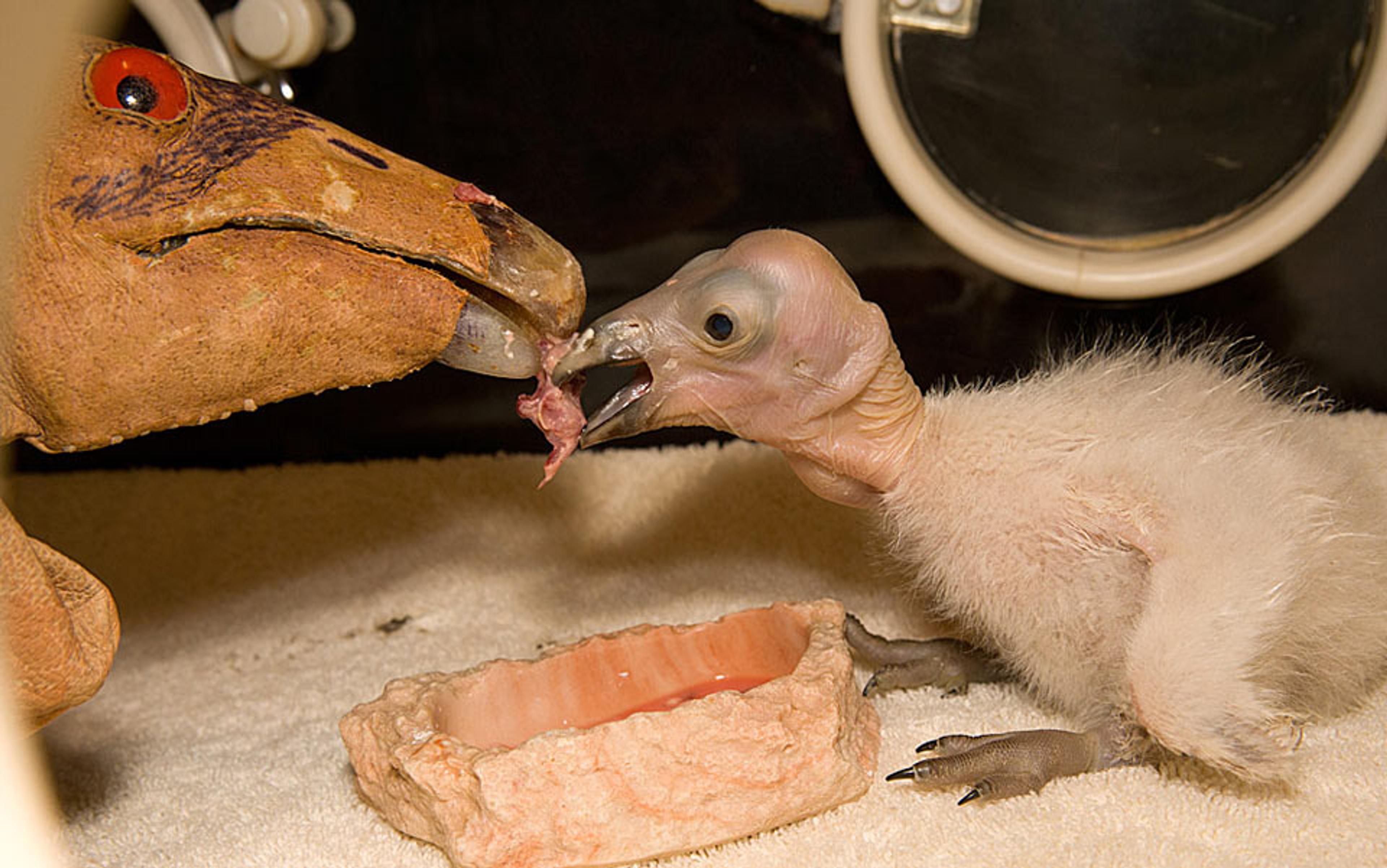
‘Captive breeding isn’t designed to save species. It’s designed to make humans feel better about ourselves’. Photo courtesy San Diego Zoo Global
The scientists and zookeepers hoped to one day release any chicks born under their care into the wild, so raising them around humans, as other captive-bred animals are often raised, was out of the question. Like many birds, condor chicks imprint powerfully on their early caretakers, and no one wanted them to bond with humans. The condor keepers were as committed to keeping the vultures wild as they were to saving them from extinction. Puppet-rearing – the practice of raising a young animal with a simulacrum of an adult of its species – seemed like the perfect solution. In this case, a particularly crafty zookeeper moulded three-dimensional hand puppets out of leather to resemble the bald head of an adult condor. Inside the breeding centre, recordings of babbling brooks drown out the ambient noise of the human world, from footsteps to the hum of fluorescent lights
Condors do two things that made them ideal subjects for puppet-rearing. The first is called double-clutching. A condor pair usually spends two years raising just one chick. But if a pair’s first egg is destroyed or otherwise lost, they’ll often lay another one during the same season. If the second attempt fails as well, they’ll repeat the process the following year. By discreetly removing eggs from condor parents’ nests and fostering the resulting chicks, zookeepers could induce double-clutching and potentially quadruple the number of eggs laid every two years, thus speeding up the population’s recovery. Double-clutching, in other words, makes puppet rearing mathematically worthwhile. Second, condor chicks are raised in near-isolation, in nests tucked into cliff caves. Often, they do not see any other birds besides their parents for the first several months of their lives; so once the captured condors started laying eggs, zookeepers sneaked off with their eggs, donned a homemade hand puppet, and took their place.
A puppet’s ability to expose the cracks in reality makes it both beautiful and frightening
Raising animals is, of course, just one of the many uses humans have found for puppets over the centuries. Puppets entertain our children, they communicate with our gods, they act out our desires, they channel our dead, they preserve our stories, they creep us out. Puppetry traditions exist all over the world, from Bali’s sacred shadow puppets to hyper-violent Punch and Judy shows in the UK to Sesame Street on TV. Plumb nearly any human culture and, somewhere, you will find puppets.
As objects of art and ritual, puppets draw their power from being what the American puppeteer Janie Geiser calls ‘substitute objects’. On stage, they take the place of a human performer. They signal emotion without feeling any themselves. They gesture without agency. Most unsettlingly, they replace life with an imitation of it. Puppets, Geiser told me, ‘are a vessel of life’ without being a living thing; ‘they suggest life’ without being alive themselves.
A puppet’s ability to expose the cracks in reality makes it both beautiful and frightening. Puppets call attention to the categories with which humans organise the world – person/thing, real/fake, object/actor, body/soul, dead/alive – at the same time as they blur the lines separating them. They raise the terrifying possibility that maybe we can’t tell the difference between nature and artifice. Or even life and death.
Condors aren’t the only endangered species to be raised by puppets. It’s been tried with numerous birds, ranging from the common raven to the bald eagle, often with great success. Across country from the condors, at the US Geological Survey Patuxent Wildlife Research Center in Maryland, whooping cranes are taught to eat, drink, and form a flock by adult crane puppet heads affixed to the hands of humans wearing something between a burka and a beekeeping suit. Even baby pandas are sometimes cared for by humans in full-body panda costumes that make them look like team mascots.
These animals don’t cause as much trouble as marauding gangs of adolescent condors, but they can wind up with their own mysterious behavioural issues. Puppet-reared whooping cranes, for example, have trouble incubating their eggs in the wild; they will often abandon their nests mere days before the eggs are due to hatch.
John French, Patuxent’s research manager and head of the crane programme, has a couple of different theories about the crane’s parenting problems. In the wild, nesting cranes are often swarmed by black flies; perhaps the puppet-reared cranes, raised in relative comfort, can’t tolerate the parasites and are driven off their nests. Or perhaps their own puppet parents failed to pass along a crucial piece of information about the breeding process. What the missing piece might be, French told me, ‘I have no idea.’ Meanwhile, the cranes’ failure to raise the next generation on their own guarantees, somewhat ironically, the need for more puppet-rearing.
This flawed but seductive logic is taken to its extreme by the burgeoning de-extinction movement
It’s tempting to see puppet-reared California condors and whooping cranes as victims of a horrific real-life version of Plato’s cave: after living in a shadow world since birth, they are suddenly dragged out into the blinding sunlight and forced to cope with an incomprehensibly rich and complex reality. Ill-equipped to live in anything but a carefully managed simulacrum of nature, they crack under the pressure. When viewed from this angle, it is hard to imagine why keepers thought puppet-rearing would produce psychologically healthy animals.
But like all intensive, hands-on conservation programmes, puppet-rearing was never really about the animals. While the stated goal of any captive breeding programme is to create self-sustaining populations of wild animals that can survive and thrive without human intervention, the true reason for their existence is guilt of a very human variety. We drove the condor, the whooping crane, the panda, and countless other species to the brink of extinction; therefore, we have a responsibility to save them. Usually, our strategy amounts to fixating on the cutest or most symbolic of these threatened species and breeding as many of them as we can. Those offspring either spend their lives in zoos or are released into the very same world that killed so many of their ancestors. This flawed but seductive logic is taken to its extreme by the burgeoning de-extinction movement, which promises to literally bring extinct species such as the passenger pigeon and the woolly mammoth back from the dead without any concurrent resurrection of the environmental contexts in which they once thrived.
Captive breeding isn’t designed to save species. It’s designed to make humans feel better about ourselves. It’s proof that whatever horrors we’re wreaking on our planet, we’re still willing to make Herculean efforts to save the animals most obviously suffering the consequences. But to effectively assuage our guilt, we need to see results – and truly successful captive breeding programmes, the ones that produce large numbers of wild animals which stay out of humans’ way, rarely give us those. Instead, we latch on to the adorable and conscience-soothing spectacle of captive breeding itself. We’re riveted by the Panda Cam, we turn up in droves to watch ultralight aircraft lead whooping cranes on their first migration. Puppet-rearing takes our love of captive breeding to the extreme by satisfying two guilt-absolving fantasies at once: it lets us play at being nature’s saviour while also symbolically erasing human beings from the face of the Earth.
This erasure of the human presence is what most starkly differentiates puppet-rearing from other forms of puppet theatre. Puppetry’s age-old appeal relies on a dissonant double vision, in which the audience sees the magic of the puppet and the skill of the puppeteer at the same time, and marvels at them both. But where a human puppet show is transparent in its falseness, puppet-rearing aims to be totally opaque.
For French and his whooping cranes, for example, the puppet heads are tangential to the costume, the robes that obscure the human wearing them. Pretending to be a crane isn’t really the point, French told me. Rather than channelling the presence of a whooping crane, his shrouded crane keepers try to perform the absence of a person. ‘I presume these birds know that we’re not cranes,’ he says. That’s OK – just as long as they still grow up to avoid humans.
The condor keepers in San Diego have an advantage when it comes to fooling the chicks in their care: they don’t have to walk around with them out in the open, wearing scary robes. Since condor chicks stay in one place for the first several months of their lives, a puppet head poked through a one-way screen will do the trick. But for the first few years of the condor-rearing programme, erasing the human presence also meant erasing any kind of disciplinary authority, which turned out to be vital to condor development. As the keepers were forced to recapture more and more misbehaving birds, like the ones around Les Reid’s house and at the Grand Canyon, they concluded that, like many juvenile delinquents, these early puppet-reared condors lacked positive adult role models. For the first several years of the release programme, it was basically a ‘Lord of the Flies model’, Michael Mace, the curator of birds at the San Diego Zoo Safari Park, told me. ‘Kids were raising kids.’
Mace counselled patience; he believed that the adolescent condors would grow out of their raucous behaviour and settle down once they started families of their own, around age five or six. But in the meantime, says Amy Utt, a biologist at Union College in Nebraska who studies the condor-recovery programme, some changes had to be made at the zoos.
In the wild, if a chick gets too clingy or does something else its parents deem not-condor-appropriate, it will get a smack
Instead of focusing primarily on the absence of humans, condor keepers began viewing their job as a performance of condor-ness. They pored over videos of live condor parents interacting with their chicks and tried to precisely mimic their movements with the hand puppets. ‘There needs to be great attention to detail,’ Mace said, because eventually, the chick will ‘exhibit those same behaviours with its own offspring.’ So instead of just dropping food into the chick’s mouth and leaving, for example, the puppets started depositing raw meat on the floor and poking around it alongside the chick. These days, the puppets play, they groom, they tidy up the nest. And perhaps most importantly, they hit.
Condor parenting is ‘not super cuddly’, Utt told me, and a big part of learning to perform the role of adult condor was to stop being so gentle with the zoo-hatched chicks. In the wild, if a chick gets too clingy or does something else its parents deem not-condor-appropriate, it will get a smack. Later on, parents will sometimes push chicks off ledges to teach them to fly. Learning to mimic this wild behaviour was no doubt challenging for the keepers, especially when every condor chick born in the zoos seemed like a tiny, fragile miracle. But roughing up the chicks early in life, Utt said, ‘seems to actually produce birds that behave more like wild birds’. What’s more, these condors will now know how they are supposed to treat their own offspring when the time comes.
There’s still only so much a hand puppet can do, however, and the condor keepers realised they needed to bring in reinforcements. The chicks’ pens now have windows through which the chicks can see real, live adult condors. Hopefully, Mace says, that gives them a sense of identity, an idea of what they are going to be when they grow up. (Something similar is done with whooping cranes at Patuxent.) At around five months, the chicks are moved to live with an older ‘mentor’ condor. These mentors teach their charges how to live with other birds and respect the condor hierarchy. And now, condors do sometimes see humans in the zoo: the growing birds are occasionally ambushed and tackled by zookeepers, to train them to be afraid of people.
Twenty-seven years after the last wild condors were rounded up and brought into captivity, the puppet-rearing programme seems to be doing its job. As of November, 227 California condors live in the wild, with another 189 in captivity. Behavioural problems have decreased, though the birds must still be closely monitored, especially for lead exposure, which continues to be the biggest threat to the species’ long-term survival. If we humans took our hand off the scale, the condor population would no doubt plummet. Still, compared to even 10 years ago, the condors ‘are doing so much better. So much better,’ Utt said.
Although few people now doubt the wisdom of saving California condors by raising them in zoos, critics of the programme were right about one thing: captive breeding does, in fact, risk altering the essence of a wild species. So does that make a puppet-reared animal a miracle or tragedy? It’s both – or maybe neither. Puppet-rearing blurs the same categorical lines as puppet theatre does. When we must capture all the wild condors and raise their children for them, what is the difference between survival and extinction? Between nature and artifice? Wild and tame? Puppet and animal? There’s fear and more than a little disgust in not being able to tell the difference. But there’s also beauty in how we’ve managed to carve out even the tiniest space between those categories and learned to live in the cracks.
A condor soaring over the Grand Canyon or the California chaparral is no longer the ‘soul of the wilderness’. It is the manifestation of the passion, care, and effort of the people who worked so hard to create the mere possibility of that moment. The set has been designed. The performer has rehearsed. The audience is prepared for rapture and amazement as a species is brought back from the brink. Yes, humans are pulling the strings. But what we’ve created is a work of art.
